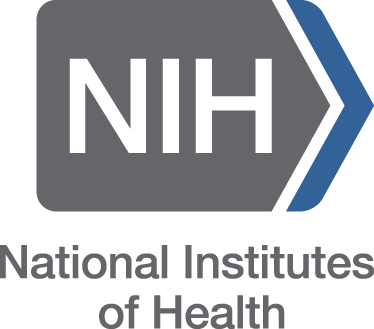Difference between revisions of "Template:Article of the week"
Shawndouglas (talk | contribs) (Updated article of the week text.) |
Shawndouglas (talk | contribs) m (Corrected article link) |
||
| Line 1: | Line 1: | ||
<div style="float: left; margin: 0.5em 0.9em 0.4em 0em;">[[File:NIH Master Logo Vertical 2Color.png| | <div style="float: left; margin: 0.5em 0.9em 0.4em 0em;">[[File:NIH Master Logo Vertical 2Color.png|140px]]</div> | ||
The '''[[National Institutes of Health]]''' ('''NIH''') is a biomedical research facility primarily located in Bethesda, Maryland, USA, operating as an agency of the [[United States Department of Health and Human Services]]. The NIH is the U.S. agency most responsible for biomedical and health-related research, primarily through its Intramural Research Program (IRP), which claims to be "the largest institution for biomedical science on earth." In addition to conducting its own research, the agency provides major biomedical research funding to non-NIH research facilities through its Extramural Research Program (ERP). For example, in 2003 the NIH and its extramural arm provided 28% of biomedical research funding spent annually in the U.S., or about $26.4 billion. | The '''[[National Institutes of Health]]''' ('''NIH''') is a biomedical research facility primarily located in Bethesda, Maryland, USA, operating as an agency of the [[United States Department of Health and Human Services]]. The NIH is the U.S. agency most responsible for biomedical and health-related research, primarily through its Intramural Research Program (IRP), which claims to be "the largest institution for biomedical science on earth." In addition to conducting its own research, the agency provides major biomedical research funding to non-NIH research facilities through its Extramural Research Program (ERP). For example, in 2003 the NIH and its extramural arm provided 28% of biomedical research funding spent annually in the U.S., or about $26.4 billion. | ||
The NIH comprises 27 separate institutes and centers that conduct research in different disciplines of biomedical science. The IRP is responsible for many scientific accomplishments, including the discovery of fluoride to prevent tooth decay, the use of lithium to manage bipolar disorder, and the creation of vaccines against hepatitis, ''Haemophilus influenzae'' (HIB), and human papillomavirus. The funding of NIH has at times been a source of contention in Congress, serving as a proxy for the political currents of the time. In fiscal year 2010, NIH spent $10.7 billion (not including temporary funding from the ARRA) on clinical research, $7.4 billion on genetics-related research, $6.0 billion on prevention research, $5.8 billion on cancer, and $5.7 billion on [[biotechnology]]. ('''[[National Institutes of Health]]''')<br /> | The NIH comprises 27 separate institutes and centers that conduct research in different disciplines of biomedical science. The IRP is responsible for many scientific accomplishments, including the discovery of fluoride to prevent tooth decay, the use of lithium to manage bipolar disorder, and the creation of vaccines against hepatitis, ''Haemophilus influenzae'' (HIB), and human papillomavirus. The funding of NIH has at times been a source of contention in Congress, serving as a proxy for the political currents of the time. In fiscal year 2010, NIH spent $10.7 billion (not including temporary funding from the ARRA) on clinical research, $7.4 billion on genetics-related research, $6.0 billion on prevention research, $5.8 billion on cancer, and $5.7 billion on [[biotechnology]]. ('''[[National Institutes of Health|Full article...]]''')<br /> | ||
<br /> | <br /> | ||
''Recently featured'': [[Laboratory information system]], [[Denuder]], [[Infectious disease informatics]] | ''Recently featured'': [[Laboratory information system]], [[Denuder]], [[Infectious disease informatics]] | ||
Revision as of 18:34, 1 December 2014
The National Institutes of Health (NIH) is a biomedical research facility primarily located in Bethesda, Maryland, USA, operating as an agency of the United States Department of Health and Human Services. The NIH is the U.S. agency most responsible for biomedical and health-related research, primarily through its Intramural Research Program (IRP), which claims to be "the largest institution for biomedical science on earth." In addition to conducting its own research, the agency provides major biomedical research funding to non-NIH research facilities through its Extramural Research Program (ERP). For example, in 2003 the NIH and its extramural arm provided 28% of biomedical research funding spent annually in the U.S., or about $26.4 billion.
The NIH comprises 27 separate institutes and centers that conduct research in different disciplines of biomedical science. The IRP is responsible for many scientific accomplishments, including the discovery of fluoride to prevent tooth decay, the use of lithium to manage bipolar disorder, and the creation of vaccines against hepatitis, Haemophilus influenzae (HIB), and human papillomavirus. The funding of NIH has at times been a source of contention in Congress, serving as a proxy for the political currents of the time. In fiscal year 2010, NIH spent $10.7 billion (not including temporary funding from the ARRA) on clinical research, $7.4 billion on genetics-related research, $6.0 billion on prevention research, $5.8 billion on cancer, and $5.7 billion on biotechnology. (Full article...)
Recently featured: Laboratory information system, Denuder, Infectious disease informatics










